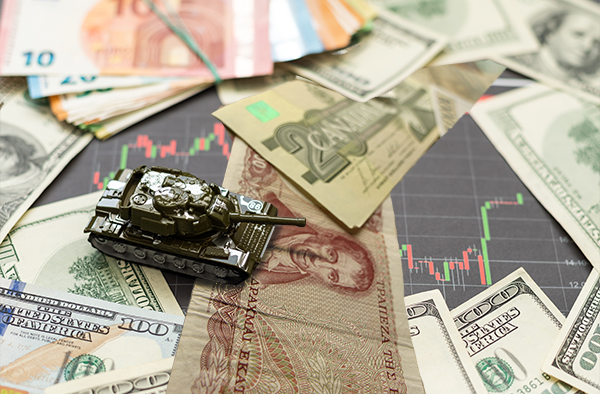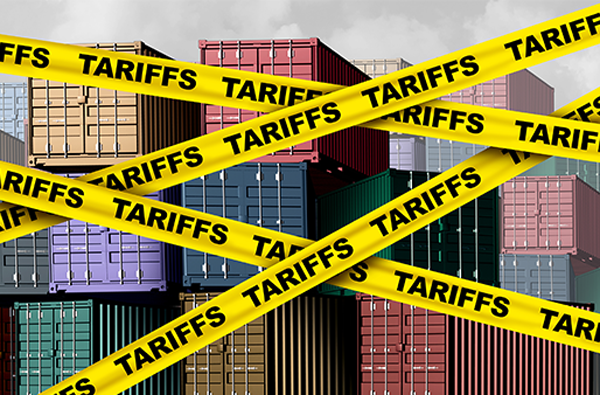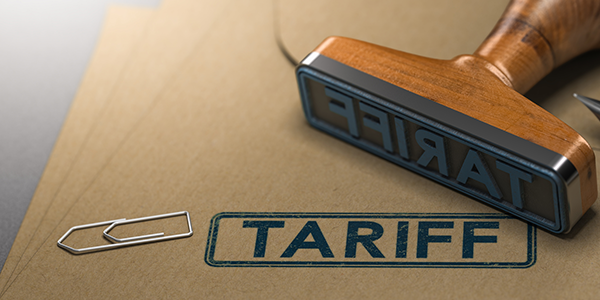
Central Bank Digital Currencies Are Off to a Rough Start
Africa’s largest economy is in the early stages of a monetary experiment that could be coming to the U.S. sooner than you think.
Nigeria may not be on a lot of people’s radars, but it should be. Africa’s largest economy is in the early stages of a monetary experiment that could be coming to the U.S. sooner than you think.
In October 2021, Nigeria’s central bank introduced the eNaira, a digital version of its currency, the naira, and so far, things aren’t going well. Nigerians aren’t using the currency, for one.
And two, the central bank has recently replaced old high-denomination banknotes with new, less counterfeitable ones. As you might expect, this has triggered a chaotic run on the banks. Cash withdrawals are reportedly limited to around $45 USD per day.
Some people believe the crisis has been engineered to push people into using the eNaira. True or not, the country isn’t giving up on the currency. Nigeria, which held a highly contested presidential election this past weekend, entered into talks last week with a New York-based technology firm to help it “keep full control” of the eNaira, according to reporting by Bloomberg.
I’ve written about the pros and cons of central bank digital currencies (CBDCs) before, and I think by now most people have developed their own opinion about them.
The thing is, CBDCs are not just for emerging and developing countries like Nigeria. Close to 90% of the world’s central banks are at some point in the process of creating their own digital currency. Sweden, already one of the most cashless societies on earth (despite it being the first country in history to issue paper banknotes), may be close to rolling out the e-krona.
Not everyone favors the idea of a centralized digital currency, and a few nations are working on legislation limiting their scope. Switzerland, whose citizens hold the most physical cash per capita, wants to enshrine the availability of paper banknotes in its constitution. Last week, a U.S. legislator introduced a bill, titled the “CBDC Anti-Surveillance State Act,” that would prohibit the Federal Reserve from issuing its own digital dollar.
It’s All About the Benjamins
Even among those who may not support the creation of a CBDC, the calls to ban certain banknotes have been growing louder over the years. The U.S. has rightfully done away with bills ranging in denomination from $500 and $100,000, and the next on the chopping block could be the $100 bill.
Supporters of this idea say that discontinuing bills bearing Ben Franklin’s face would go a long way in combating corruption, terrorism and other illicit activities, particularly overseas. Believe it or not, a vast majority of $100 bills are held abroad—an estimated 80% of them, according to the Chicago Fed. Demand rises in times of political and financial crisis.
With Benjamins now being the most printed U.S. currency, having overtaken both the $20 bill and $1 bill in recent years, the amount of money that exists outside the American financial system is substantial.
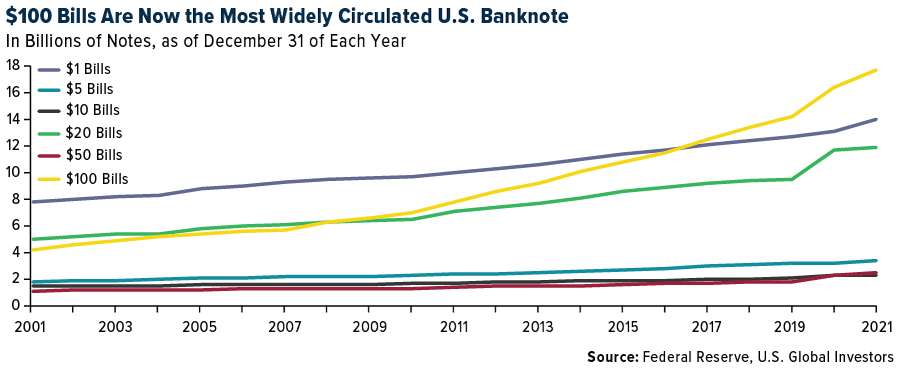
I don’t know what the solution to this is, but eliminating the $100 bill seems extreme to me. What would that do to the value of the U.S. dollar? How would that affect people’s faith in our monetary system? We see what’s happening in Nigeria.
Similarly, I don’t believe CBDCs are the solution. Unlike Bitcoin, CBDCs are by definition centralized. They’re also traceable and programmable, with potentially chilling consequences.
In Gold We Trust
This only improves the investment thesis for gold, silver, collectibles, real estate and other hard assets. Although not as liquid or portable as cash, hard assets are attractive stores of value because they’re private property, not issued by a central authority.
The same goes for Bitcoin, gold’s digital cousin. The only way to produce a new Bitcoin or new ounce of gold is through intensive work, a literal conversion of time and energy. No central banker or finance minister can unilaterally affect supply with a snap of their fingers.
It’s for this reason that central banks like gold. They collectively bought a near-record amount of the yellow metal last year, and some analysts forecast they’ll buy even more this year.
Could Bitcoin end up on banks’ balance sheets? It’s not as crazy as it sounds. In December 2022, the Bank of International Settlements (BIS), often called the “central bank of central banks,” released guidance on banks’ exposure to crypto assets. The standard, which goes into effect in 2025, limits that exposure to 2%.
American Exceptionalism
I want to leave you with something that was shared with me recently. Last month I attended Harvard Business School Case Studies, where I finally received my MBA after several years of attending. (I like to joke that I’m a slow learner.)
Larry Summers—former Treasury Secretary and current President Emeritus of Harvard—reminded us how remarkable it is that the total market cap of U.S. stocks represents over 40% of total world equities. This is true despite the U.S. economy representing around 16% of global GDP and its population representing less than 5% of the world’s population.
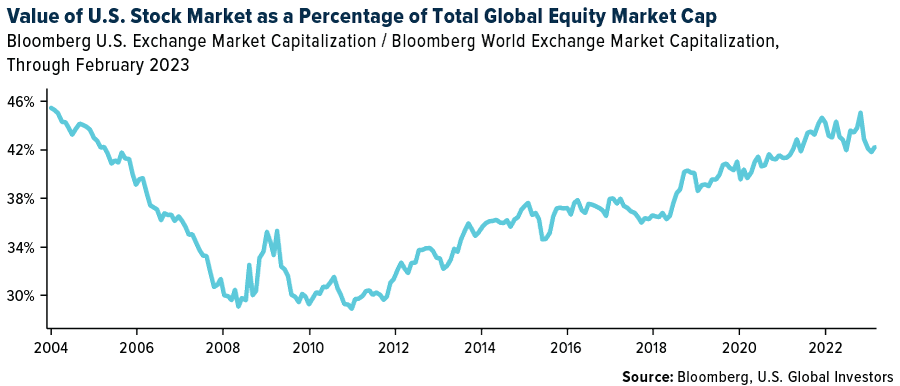
Summers’ words reinforce my belief that it’s unwise to bet against the U.S., no matter who’s in charge or what else is going on in the world. American exceptionalism is much more than a pie-in-the-sky concept—it’s apparent in the strength of our institutions and capital markets.
I will be speaking more on decentralized assets like gold and Bitcoin at the Swiss Mining Institute’s annual conference, to be held March 21 and 22. Get your tickets by clicking here!
All opinions expressed and data provided are subject to change without notice. Some of these opinions may not be appropriate to every investor. By clicking the link(s) above, you will be directed to a third-party website(s). U.S. Global Investors does not endorse all information supplied by this/these website(s) and is not responsible for its/their content.









